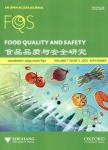Occurrence of mycotoxins in food,feed,and milk in two counties from different agro-ecological zones and with historical outbreak of aflatoxins and fumonisins poisonings in Kenya
作者机构:Department of Public HealthPharmacology and ToxicologyUniversity of NairobiBox 29053-00625 NairobiKenya Ministry of AgricultureLivestock and FisheriesPrivate Bag KabeteNairobiKenya Jomo Kenyatta University of Agriculture and TechnologyBox 62000-00200NairobiKenya Natural Resources Institute Finland LUKEJokioinen F1-31600JokioinenFinland Finnish Food Safety Authority EVIRA Mustialankatu 300790HelsinkiFinland
出 版 物:《Food Quality and Safety》 (食品品质与安全研究(英文版))
年 卷 期:2017年第1卷第3期
页 面:161-169页
核心收录:
基 金:the Ministry of Foreign Affairs of Finland for providing financial assistance that enabled this study(MFA 24819801) the communities in Nandi and Makueni for allowing to carry out the study and Government officers in both counties for their facilitation
主 题:aflatoxins fumonisins contamination cereals agro-ecological zones Kenya.
摘 要:Aflatoxins and fumonisins contaminate cereals during pre-and post-harvest *** this study,household or market maize,sorghum,millet,cow or goat milk,and animal feed samples collected from two counties(Makueni and Nandi)of Kenya and were analyzed for aflatoxins and fumonisins using competitive enzyme-linked immunosorbent assay and confirmation with high performance liquid *** was a significant difference(P0.005)in the levels of aflatoxins between the home grown and market-sourced maize,sorghum,and millet *** Makueni,24.8%of home maize and 44.6%of the market maize samples exceeded the 10 ppb limit for *** all,93%and 90%of the maize samples were contaminated with fumonisins and 34%and 6%exceeded the 2 ppm limit in Makueni and Nandi,respectively;30%and 37%of homegrown sorghum and millet samples exceeded the 10 ppb limit for aflatoxin in Makueni and Nandi,respectively;and 89%and 81%of homegrown millet samples in Makueni and Nandi,respectively,were positive for fumonisins and 22%and 7%in Makueni and Nandi,respectively,exceeded the 2 ppm fumonisins *** total,52%and 87%of the milk samples in Nandi and Makueni,respectively,were contaminated with aflatoxin M1 and 8%of the samples from Makueni exceeded the 50 ppt *** is an urgent need to build capacity among the households on cheap,practical,and effective technologies that would reduce the proportions of food samples contaminated with aflatoxins and fumonisins.



